Interdecadal Variation of the Antarctic Circumpolar Wave Based on the 20CRV3 Dataset
Abstract
1. Introduction
2. Data and Methods
2.1. Data
2.2. Analysis Methods
3. Large-Scale Climate Indices
4. Results
4.1. Results of the Sea Level Pressure
4.2. Results of the Sea Surface Temperature
4.3. SVD Results
5. Conclusions and Discussion
- The ACW signal can be linearly decomposed into the ACW-2 and ACW-3 components, with the ACW-2 pattern dominating.
- The ACW-2 pattern for the SLP is associated with the SAM and PSA, while the SST is mainly affected by ENSO. The ACW-2 signal in the SLP is ahead of that in the SST by approximately 1–2 months.
- The ACW is most significant in the South Pacific, while it is most fuzzy in the southern Indian Ocean.
- The ACW is not persistent in SLP and SST fields from 1836 to 2015 and has remarkable interdecadal variation. The fluctuation amplitude of the ACW is weak, which cannot distinguish the ACW signal from the background disturbance before the 1870s. During the 1880s–1940s, part of the east-propagating SLP signal can be found intermittently in the South Pacific and Atlantic. A similar situation can be found in the 1880s–1960s for the SST. The most significant signal appears during the 1950s–1990s for the SLP and during the 1970s–1990s for the SST. Both of them weaken in the 21st century.
- The SLP has an interdecadal phase shift in the 1950s, and the amplitude strengthens thereafter. The change may be related to the interdecadal variation of the SAM and PSA associated with the ACW-2 pattern. The interdecadal phase shift of SST appears in the 1970s, which may be due to the change of ENSO.
Author Contributions
Funding
Institutional Review Board Statement
Informed Consent Statement
Data Availability Statement
Acknowledgments
Conflicts of Interest
References
- White, W.B.; Peterson, R.G. An Antarctic Circumpolar Wave in surface pressure, wind, temperature and sea-ice extent. Nature 1996, 380, 699–702. [Google Scholar] [CrossRef]
- Jacobs, G.A.; Mitchell, J.L. Ocean circulation variations associated with the Antarctic Circumpolar Wave. Geophys. Res. Lett. 1996, 23, 2947–2950. [Google Scholar] [CrossRef]
- Bonekamp, H.; Sterl, A.; Komen, G.J. Interannual variability in the Southern Ocean from an ocean model forced by European Centre for Medium-Range Weather Forecasts reanalysis fluxes. J. Geophys. Res. Earth Surf. 1999, 104, 13317–13331. [Google Scholar] [CrossRef]
- Yuan, X.; Martinson, D.G. Antarctic Sea Ice Extent Variability and Its Global Connectivity. J. Clim. 2000, 13, 1697–1717. [Google Scholar] [CrossRef]
- Christoph, M.; Barnett, T.P.; Roeckner, E. The Antarctic Circumpolar Wave in a Coupled Ocean–Atmosphere GCM. J. Clim. 1998, 11, 1659–1672. [Google Scholar] [CrossRef]
- Cai, W.; Baines, P.G.; Gordon, H.B. Southern Mid- to High-Latitude Variability, a Zonal Wavenumber-3 Pattern, and the Antarctic Circumpolar Wave in the CSIRO Coupled Model. J. Clim. 1999, 12, 3087–3104. [Google Scholar] [CrossRef]
- White, W.B.; Cayan, D.R. A global El Niño-Southern Oscillation wave in surface temperature and pressure and its interdecadal modulation from 1900 to 1997. J. Geophys. Res. Earth Surf. 2000, 105, 11223–11242. [Google Scholar] [CrossRef]
- Cai, W.; Baines, P.G. Forcing of the Antarctic Circumpolar Wave by El Niño-Southern Oscillation teleconnections. J. Geophys. Res. Earth Surf. 2001, 106, 9019–9038. [Google Scholar] [CrossRef]
- Cerrone, D.; Fusco, G.; Cotroneo, Y.; Simmonds, I.; Budillon, G. The Antarctic Circumpolar Wave: Its Presence and Interdecadal Changes during the Last 142 Years. J. Clim. 2017, 30, 6371–6389. [Google Scholar] [CrossRef]
- Venegas, S.A. The Antarctic Circumpolar Wave: A Combination of Two Signals? J. Clim. 2003, 16, 2509–2525. [Google Scholar] [CrossRef]
- Wang, X.; Giannakis, D.; Slawinska, J. The Antarctic Circumpolar Wave and its seasonality: Intrinsic travelling modes and El Niño-Southern Oscillation teleconnections. Int. J. Clim. 2018, 39, 1026–1040. [Google Scholar] [CrossRef]
- Zhou, Q.; Zhao, J.; He, Y. Review of Studies of the Antarctic Circumpolar Wave. Adv. Earth Sci. 2004, 19, 761–766. (In Chinese) [Google Scholar] [CrossRef]
- White, W.B. Influence of the Antarctic Circumpolar Wave on El Niño and its multidecadal changes from 1950 to 2001. J. Geophys. Res. Earth Surf. 2004, 109, C06019. [Google Scholar] [CrossRef]
- White, W.B.; Cherry, N.J. Influence of the Antarctic Circumpolar Wave upon New Zealand Temperature and Precipitation during Autumn–Winter. J. Clim. 1999, 12, 960–976. [Google Scholar] [CrossRef]
- White, W.B. Tropical Coupled Rossby Waves in the Pacific Ocean–Atmosphere System. J. Phys. Oceanogr. 2000, 30, 1245–1264. [Google Scholar] [CrossRef]
- Xie, J.P.; Guo, P.W.; Wang, Y.L. Antarctic Circumpolar Waves and Its Association with the Abnormality of Summer Rainfall over China. J. Nanjing Inst. Meteorol. 2005, 28, 376–383. (In Chinese) [Google Scholar] [CrossRef]
- Prabhu, A.; Mahajan, P.N.; Khaladkar, R.M.; Chipade, M.D. Role of Antarctic Circumpolar Wave in modulating the extremes of Indian summer monsoon rainfall. Geophys. Res. Lett. 2010, 37, L14106. [Google Scholar] [CrossRef]
- Huang, N.E.; Shen, Z.; Long, S.R.; Wu, M.C.; Shih, H.H.; Zheng, Q.; Yen, N.-C.; Tung, C.C.; Liu, H.H. The empirical mode decomposition and the Hilbert spectrum for nonlinear and non-stationary time series analysis. Proc. R. Soc. Lond. Ser. A Math. Phys. Eng. Sci. 1998, 454, 903–995. [Google Scholar] [CrossRef]
- Comiso, J.C. Variability and Trends in Antarctic Surface Temperatures from In Situ and Satellite Infrared Measurements. J. Clim. 2000, 13, 1674–1696. [Google Scholar] [CrossRef]
- Cerrone, D.; Fusco, G.; Simmonds, I.; Aulicino, G.; Budillon, G. Dominant Covarying Climate Signals in the Southern Ocean and Antarctic Sea Ice Influence during the Last Three Decades. J. Clim. 2017, 30, 3055–3072. [Google Scholar] [CrossRef]
- Moroi, T.; Kitoh, A.; Koide, H. Antarctic Circumpolar Wave in a coupled ocean-atmosphere model. Ann. Glaciol. 1998, 27, 483–487. [Google Scholar] [CrossRef]
- Belkin, I.M. Comments on “Southern Mid- to High-Latitude Variability, a Zonal Wavenumber-3 Pattern, and the Antarctic Circumpolar Wave in the CSIRO Coupled Model”. J. Clim. 2001, 14, 1329–1331. [Google Scholar] [CrossRef]
- Cai, W.; Baines, P.G.; Gordon, H.B. Reply. J. Clim. 2001, 14, 1332–1334. [Google Scholar] [CrossRef]
- Xiao, C.; Chen, Y.; Ren, J.; Lu, L.; Li, Z.; Qin, D.; Zhou, X. Signals of Antarctic Circumpolar Wave over the Southern Indian Ocean as recorded in an Antarctica ice core. Chin. Sci. Bull. 2005, 50, 347–355. [Google Scholar] [CrossRef]
- Bian, L.; Lin, X. Interdecadal change in the Antarctic Circumpolar Wave during 1951–2010. Adv. Atmos. Sci. 2012, 29, 464–470. [Google Scholar] [CrossRef]
- Lin, X.; Bian, L. Characteristics of the Antarctic Circumpolar Wave during Recent 100 Years. Clim. Environ. Res. 2015, 20, 21–29. (In Chinese) [Google Scholar]
- Gloersen, P.; Huang, N.E. In search of an elusive Antarctic Circumpolar Wave in sea ice extents: 1978–1996. Polar Res. 1999, 18, 167–173. [Google Scholar] [CrossRef]
- Giarolla, E.; Matano, R.P. The Low-Frequency Variability of the Southern Ocean Circulation. J. Clim. 2013, 26, 6081–6091. [Google Scholar] [CrossRef][Green Version]
- Slivinski, L.C.; Compo, G.P.; Whitaker, J.S.; Sardeshmukh, P.D.; Giese, B.S.; McColl, C.; Allan, R.; Yin, X.; Vose, R.; Titchner, H.; et al. Towards a more reliable historical reanalysis: Improvements for version 3 of the Twentieth Century Reanalysis system. Q. J. R. Meteorol. Soc. 2019, 145, 2876–2908. [Google Scholar] [CrossRef]
- Turner, J.; Colwell, S.R.; Marshall, G.J.; Lachlan-Cope, T.A.; Carleton, A.M.; Jones, P.D.; Lagun, V.; Reid, P.A.; Iagovkina, S. The SCAR READER Project: Toward a High-Quality Database of Mean Antarctic Meteorological Observations. J. Clim. 2004, 17, 2890–2898. [Google Scholar] [CrossRef]
- Prohaska, J.T. A Technique for Analyzing the Linear Relationships between Two Meteorological Fields. Mon. Weather Rev. 1976, 104, 1345–1353. [Google Scholar] [CrossRef]
- Thompson, D.W.J.; Wallace, J.M. Annular Modes in the Extratropical Circulation. Part I: Month-to-Month Variability. J. Clim. 2000, 13, 1000–1016. [Google Scholar] [CrossRef]
- Gong, D.; Wang, S. Definition of Antarctic Oscillation index. Geophys. Res. Lett. 1999, 26, 459–462. [Google Scholar] [CrossRef]
- Mo, K.C.; Ghil, M. Statistics and Dynamics of Persistent Anomalies. J. Atmos. Sci. 1987, 44, 877–902. [Google Scholar] [CrossRef]
- Karoly, D.J. Southern Hemisphere Circulation Features Associated with El Niño-Southern Oscillation Events. J. Clim. 1989, 2, 1239–1252. [Google Scholar] [CrossRef]
- Mo, K.C.; White, G.H. Teleconnections in the Southern Hemisphere. Mon. Weather Rev. 1985, 113, 22–37. [Google Scholar] [CrossRef]
- Simmonds, I.; King, J.C. Global and hemispheric climate variations affecting the Southern Ocean. Antarct. Sci. 2004, 16, 401–413. [Google Scholar] [CrossRef]
- Bian, L.; Lin, X. Interdecadal change of the Atlantic oscillation and the Antarctic Circumpolar Wave. Chin. J. Atmos. Sci. 2009, 33, 251–260. (In Chinese) [Google Scholar]
- Li, Y.; Zhao, J. A study on the Antarctic circumpolar wave mode-A coexistence system of standing and traveling wave. Chin. J. Polar Sci. 2006, 17, 100–110. [Google Scholar]
- Mélice, J.-L.; Lutjeharms, J.R.E.; Goosse, H.; Fichefet, T.; Reason, C.J.C. Evidence for the Antarctic circumpolar wave in the sub-Antarctic during the past 50 years. Geophys. Res. Lett. 2005, 32, L14614. [Google Scholar] [CrossRef]
- Slivinski, L.C.; Compo, G.P.; Sardeshmukh, P.D.; Whitaker, J.S.; McColl, C.; Allan, R.J.; Brohan, P.; Yin, X.; Smith, C.A.; Spencer, L.J.; et al. An Evaluation of the Performance of the Twentieth Century Reanalysis Version 3. J. Clim. 2021, 34, 1417–1438. [Google Scholar] [CrossRef]
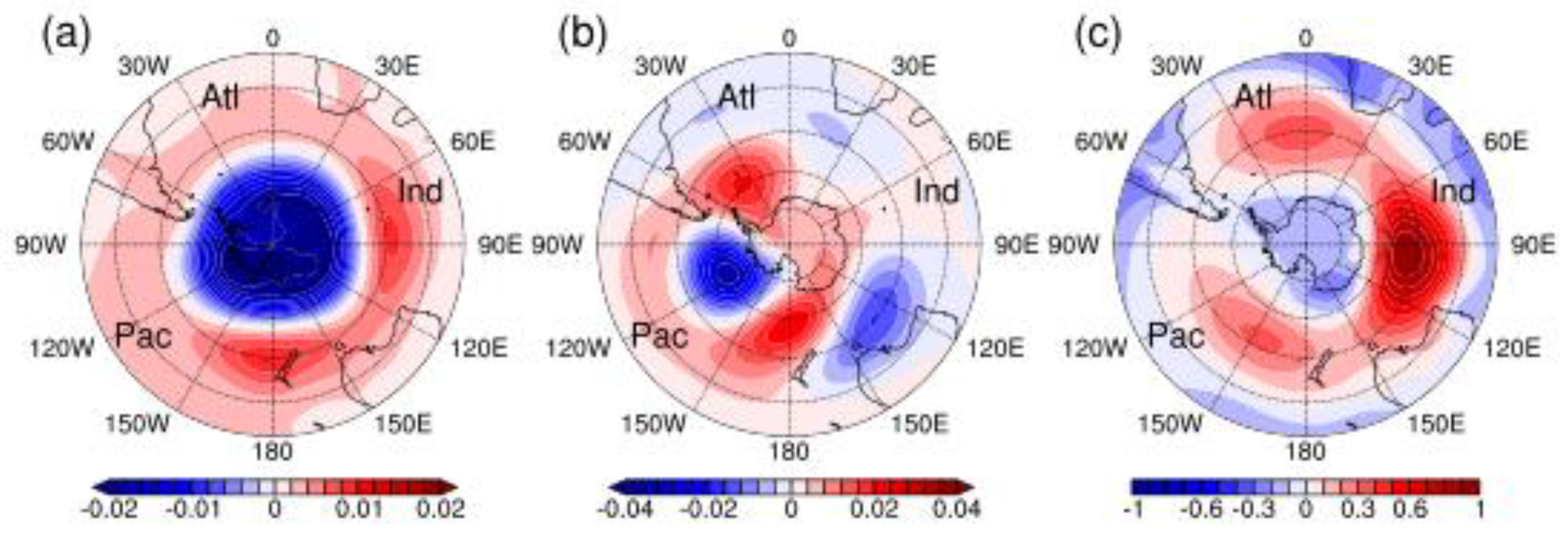
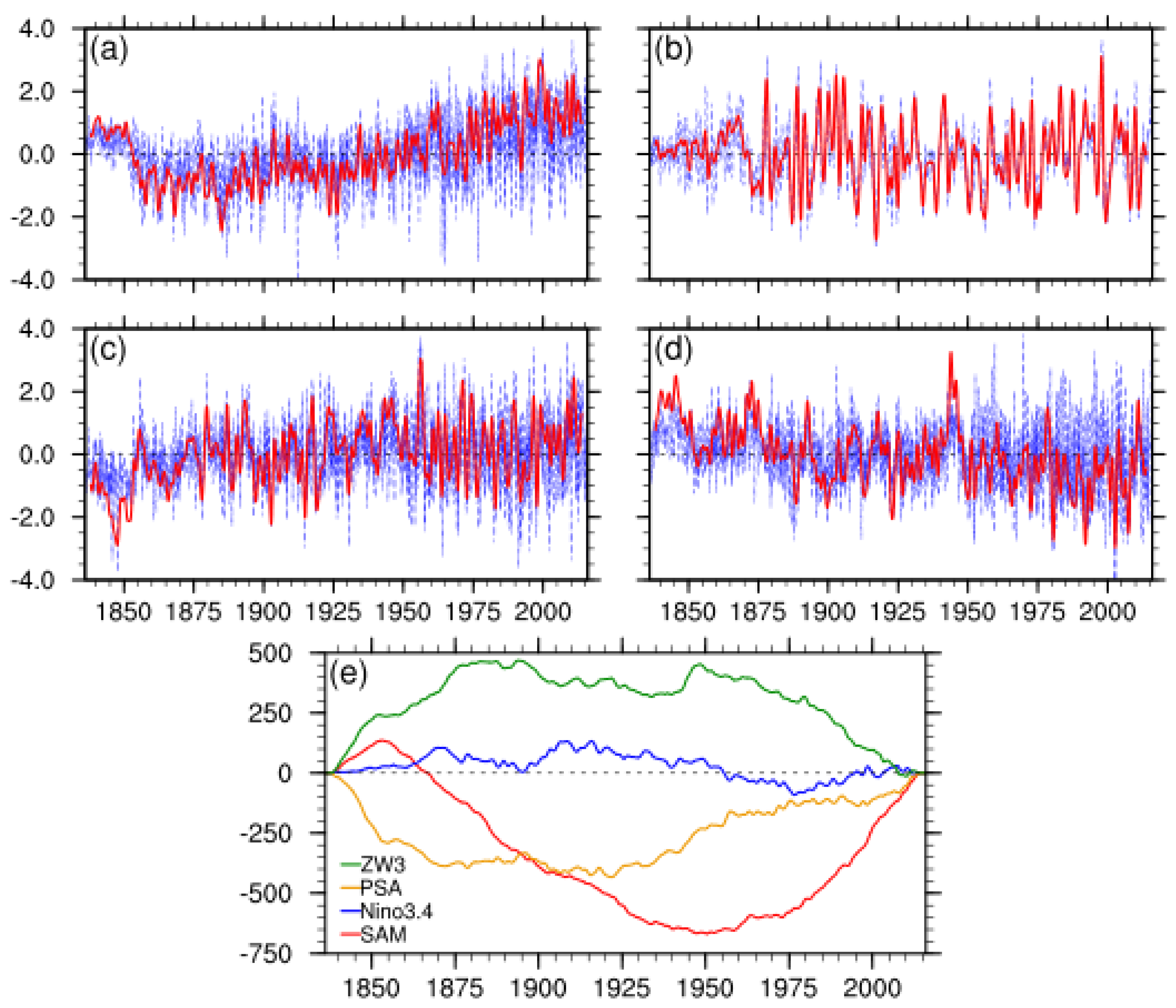
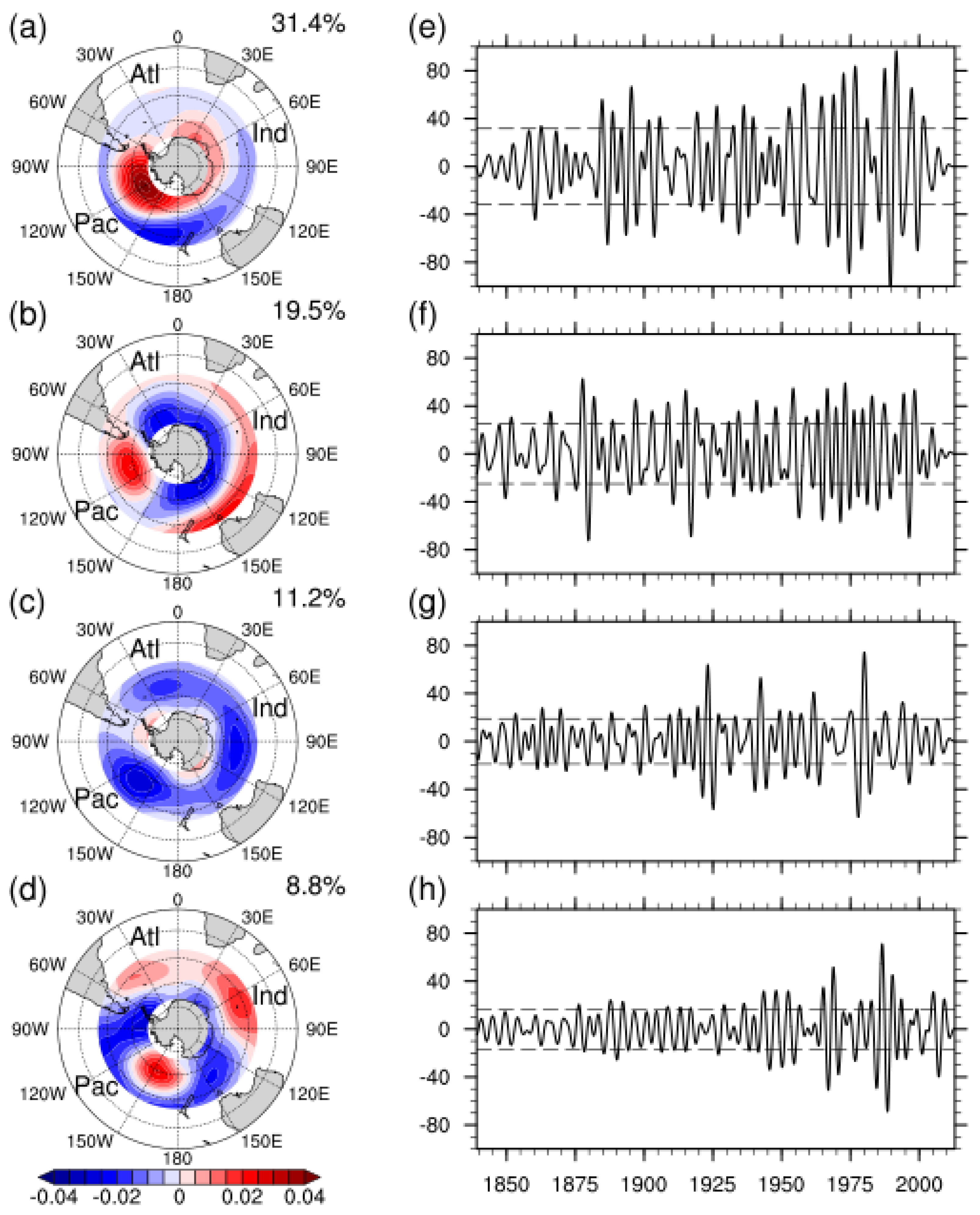

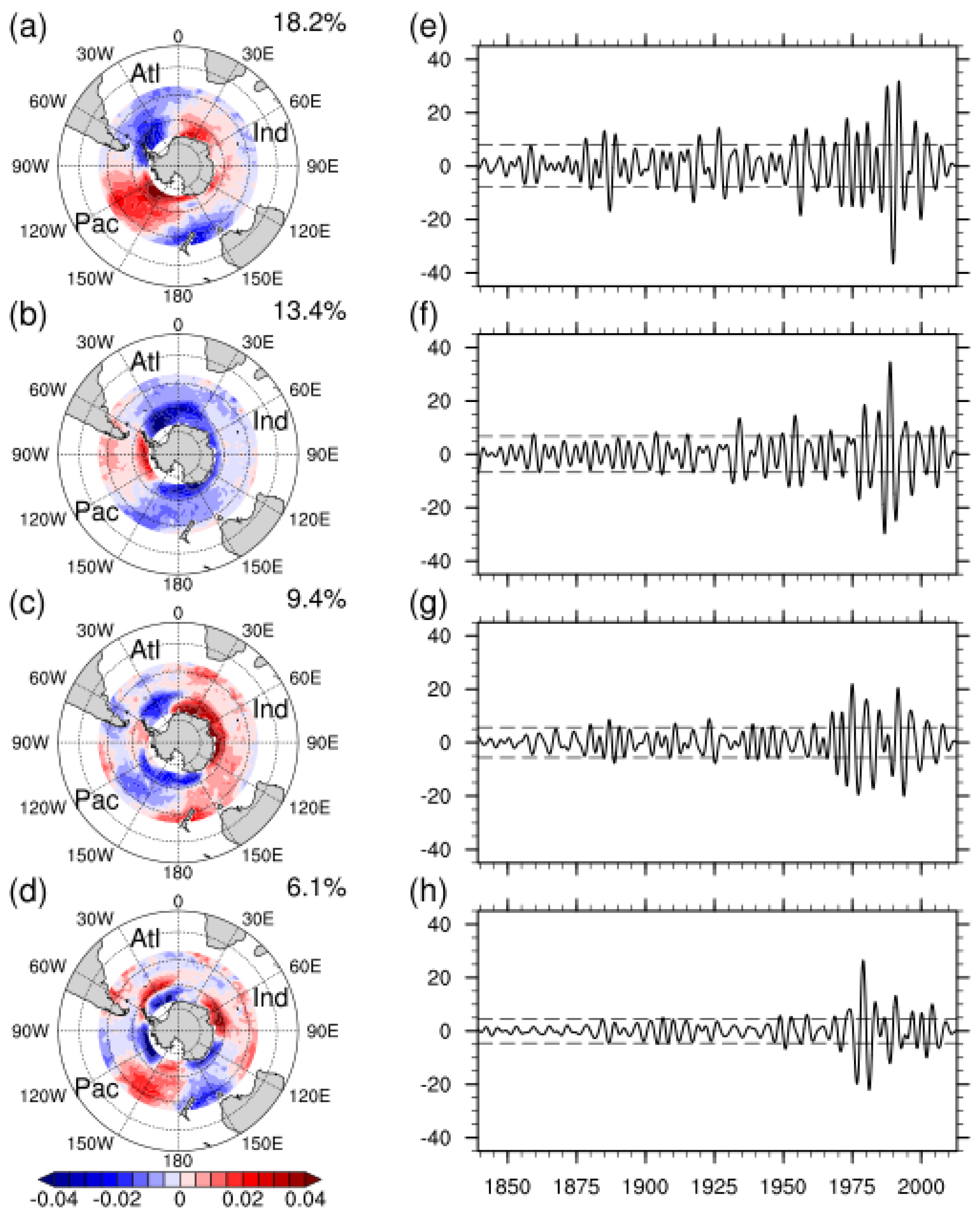
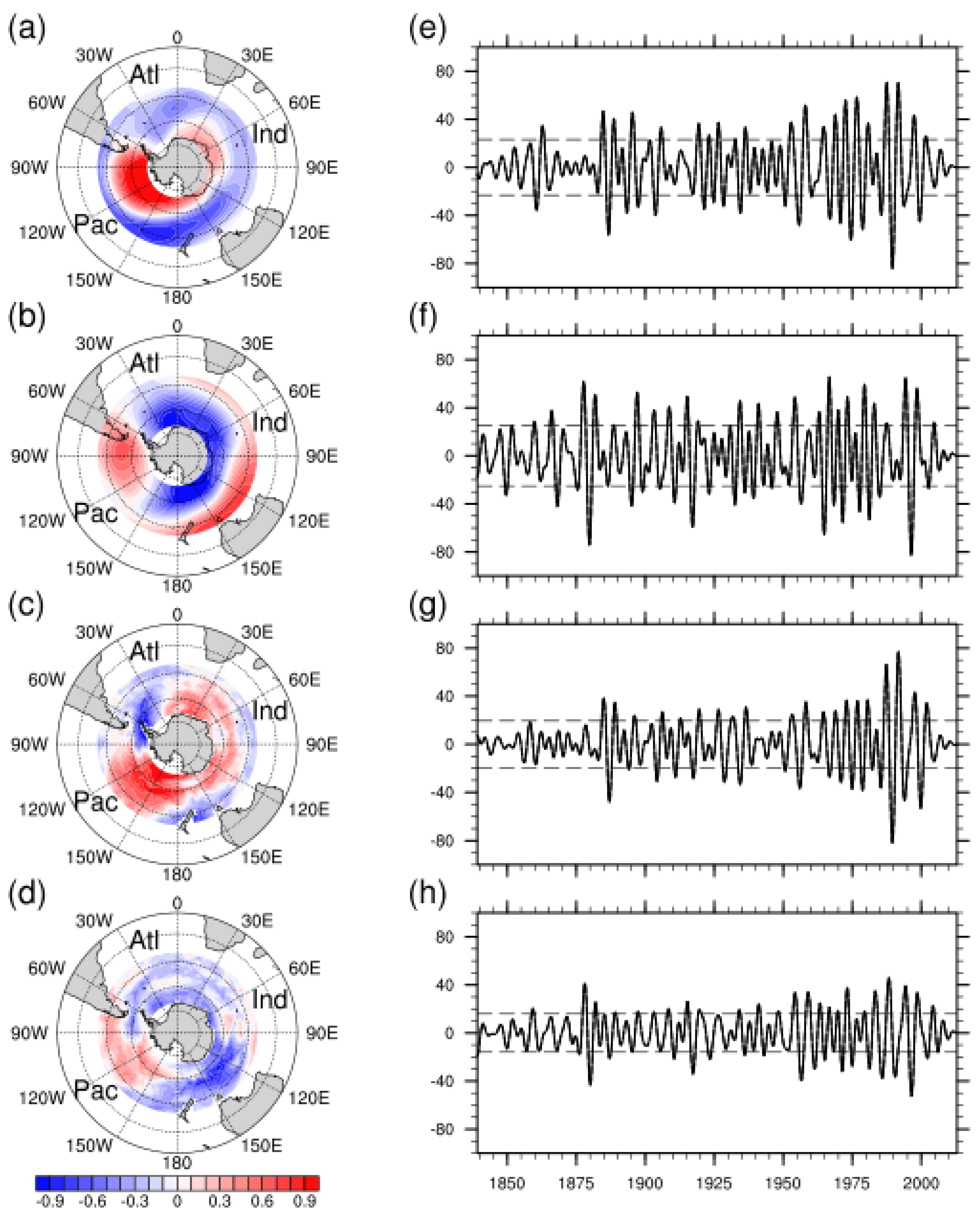
Publisher’s Note: MDPI stays neutral with regard to jurisdictional claims in published maps and institutional affiliations. |
© 2022 by the authors. Licensee MDPI, Basel, Switzerland. This article is an open access article distributed under the terms and conditions of the Creative Commons Attribution (CC BY) license (https://creativecommons.org/licenses/by/4.0/).
Share and Cite
Lu, Z.; Zhao, T.; Zhou, W.; Zhao, H. Interdecadal Variation of the Antarctic Circumpolar Wave Based on the 20CRV3 Dataset. Atmosphere 2022, 13, 736. https://doi.org/10.3390/atmos13050736
Lu Z, Zhao T, Zhou W, Zhao H. Interdecadal Variation of the Antarctic Circumpolar Wave Based on the 20CRV3 Dataset. Atmosphere. 2022; 13(5):736. https://doi.org/10.3390/atmos13050736
Chicago/Turabian StyleLu, Zhichao, Tianbao Zhao, Weican Zhou, and Haikun Zhao. 2022. "Interdecadal Variation of the Antarctic Circumpolar Wave Based on the 20CRV3 Dataset" Atmosphere 13, no. 5: 736. https://doi.org/10.3390/atmos13050736
APA StyleLu, Z., Zhao, T., Zhou, W., & Zhao, H. (2022). Interdecadal Variation of the Antarctic Circumpolar Wave Based on the 20CRV3 Dataset. Atmosphere, 13(5), 736. https://doi.org/10.3390/atmos13050736





